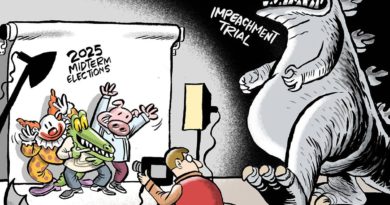Belt and Road greases the wheels of ASEAN
Jaime Augusto Zobel de Ayala, chair and chief executive officer of Ayala, the oldest and largest conglomerate in the Philippines, speaks at panel session “Partnerships with ASEAN: Growth through Infrastructure” during Hong Kong’s Belt and Road Summit. Photo: Supplied
.

.
ASEAN countries, with their enormous demand for infrastructure investments, should capitalise on China’s Belt and Road Initiative (BRI), business leaders from the ASEAN region urged. But there is a necessity to align the BRI with the ASEAN blueprint, and ASEAN needs to iron out the problems derived from the tension between Japan’s involvement in ASEAN infrastructure and China’s increasing presence.
Jointly organised by Hong Kong’s government and the Hong Kong Trade Development Council (HKTDC), the Belt and Road Summit 2017 was held on September 11 in the city.
Vincent Lo, HKTDC chair, told The Myanmar Times that ASEAN countries are “ready” and “keen” to work with Belt and Road, while the city’s leader, Carrie Lam, stated that ASEAN economies and the bloc’s geography make it a core part of Beijing’s grand scheme.
Chaired by Bernard Chan, president of Asia Financial Holdings, the panel session “Partnerships with ASEAN: Growth through Infrastructure” discussed the role of the private sector and potential for infrastructure development in ASEAN.
There is a tremendous potential for infrastructure projects in the bloc, according to the speakers. The countries need infrastructure to maintain economic growth. Private enterprises will inevitably play a bigger role in infrastructure development as governments are limited in their capacity to borrow or take from tax revenues.
Amid anaemic global economic growth, economic performance in ASEAN remains tantalising, with enormous potential in its infrastructure sector. Not only will such developments bring immediate economic benefits such as boosting employment and industrial demand, they will also grease the wheels of long-term developments in manufacturing, cross-border trade and logistics.
The speakers added that businesses should take a prudent approach to political, financial and security risks before considering projects in many Belt and Road countries. Suggested solutions of mitigating risks include partnering with domestic companies in the host country, training and hiring local people, consulting local communities, and ensuring that projects create a “win-win situation”, which benefits the host country, all partnering firms and the local community.
Aligning ASEAN and BRI
Jaime Augusto Zobel de Ayala, chair and chief executive officer of Ayala, said that the Philippines was late to the game, but that in the past year Manila had indicated clearly that it wants to align itself more formally with the BRI which can help support the tremendous need for infrastructure in the country. Ayala is the oldest and largest conglomerate in the Philippines.
“A major question for ASEAN is how to work with China,” he remarked.
 Chairul Tanjung, chair of CT Corp, one of Indonesia’s largest conglomerates, speaks at panel session “Partnerships with ASEAN: Growth through Infrastructure” during Hong Kong’s Belt and Road Summit. Photo: Supplied
Chairul Tanjung, chair of CT Corp, one of Indonesia’s largest conglomerates, speaks at panel session “Partnerships with ASEAN: Growth through Infrastructure” during Hong Kong’s Belt and Road Summit. Photo: Supplied
.
Chairul Tanjung, chair of CT Corp, one of Indonesia’s largest conglomerates, emphasised that both ASEAN and the BRI prioritises connectivity and financing, and hence there is a need to align the two ambitions.
ASEAN has a plan to increase connectivity, people-to-people movement and financing among its members, but that will require a lot of money. Belt and Road is a similar plan, so there is a need to align the two. – Chairul Tanjung, CT Corp
Infrastructure is now the top priority of the Indonesian government, he went on. The Indonesian and Chinese leaders recently discussed the implementation process of the BRI.
One problem Mr Tanjung highlighted is that Japan has been involved in Indonesia’s infrastructure development for decades and China’s implementation system is different. The challenge is how to manage the potential conflicts when implementing the BRI in Indonesia and ASEAN.
In addition, Mr de Ayala suggested that there should be more efforts to connect private companies instead of government-to-government deals, since governments often lack the financial capacity to carry out infrastructure projects on their own. He noted that the 10 largest companies in the Philippines are now involved in infrastructure projects.
Financing infrastructure
Financing infrastructure projects remains the major obstacle, according to Mr Tanjung. The funding usually comes from government budgets, “state-owned enterprises” or bank loans. But now the limitations are obvious so the Indonesian government is willing to give 30-40-year concessions for infrastructure projects. This results in an 11-15 percent return on port, toll road, airport and rail projects, “the most generous anywhere”. He went on to suggest that someone needs to bridge the communication gap between China and ASEAN, and Hong Kong is well-positioned to do so.
“If you want a growth rate of 6-8 percent, you need the infrastructure. But the capacity of government is limited, so you need private-sector involvement to speed it up,” Mr de Ayala observed.
The current Philippines government is aligned to the BRI. The BRI is “a rare opportunity” because infrastructure is considerably behind in Southeast Asia. He cited an Asian Development Bank (ADB) report last year to argue that the infrastructure gap in ASEAN will be about US$1.7 trillion per year for over a decade, but governments are only able to cover about 40-50 percent of the demand. The rest will have to come from other sources, which makes Belt and Road a welcome initiative.
He noted that public-private partnerships (PPPs) are becoming more common but ASEAN countries need to share their experience and expertise on PPPs, including successful case studies and failures.
The panel speakers agreed that risks could be mitigated by leveraging local partners and approaching the project with local support and taking into account the local context.
Local, local, local
Keith Griffiths, founder and chair of international architectural firm Aedas, argued that the solution is to employ local people. You need local knowledge. You need a network along Belt and Road, with local people trained and employed by you.
Wen Gang, Vice President of China Communications Construction – China’s largest port construction and design company – highlighted the need to understanding the local community, culture and institutions.
“You may have to deal with political risks and cultural conflicts, for example, so you need a full understanding of each country’s civilisation and culture.
“You need to listen to the voice of the people. Listen. Don’t make assumptions.
“Leverage the advantages of your local partners. Learn about the various legal institutions. It’s all about sharing and mutual benefits. Cooperation is key. Work with all stakeholders,” he commented.
Mr Tanjung warned that being aggressive makes people nervous.
“If you are too aggressive, you make people nervous. You need to explain your goals and show an interest in fairness and improvement,” he said. BRI project companies should show an understanding and appreciation of the local culture, but the most important thing is to find a good local partner.
Mr de Ayala added that it is of vital importance for BRI-led projects to create job opportunities for the local community, instead of bringing in foreign labourers. In a country like the Philippines, providing local employment is “extremely important” due to the population size and the high unemployment rate.
The CT Corp chair concluded that Indonesia is especially open to investments from ASEAN countries “because they understand each other better”. For example, Singapore is the biggest investor in Indonesia because the two countries know and understand each other well. The solution for companies in other countries is to find a good local partner and they will make a lot of money.
When asked about China’s plans to develop railways in Myanmar, Meng Fengchao, chair of the state-owned China Railway Construction Corporation (CRCC), said that his company remains involved in discussions on potential developments, but the details of discussions are confidential at this stage. The CRCC is the second-largest construction and engineering company in the world by revenue.
In the preceding session, chair of Hong Kong’s Financial Services Development Council Laura Cha cited the example of Kunming-Kyaukphyu railway network to illustrate that regional cooperation efforts have always existed, but the Belt and Road has brought regional cooperation to a new level.
<>
[email protected] |For comments,














